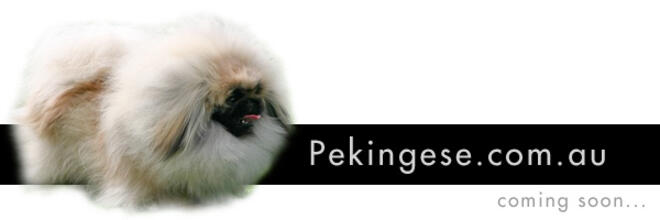
THE PEKINGESE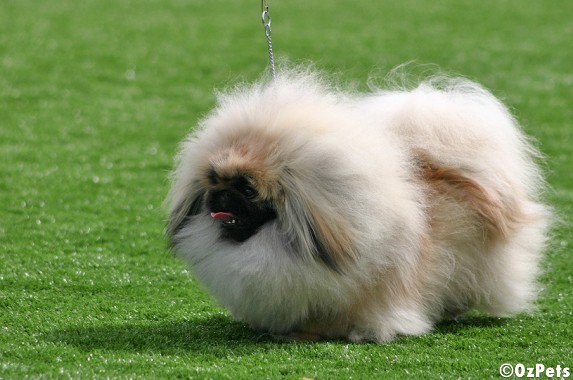 Pekingese or Pekinese is an ancient breed of toy dog, originating in China. They were the favored pet of the Chinese Imperial court, and the name relates to the city of Beijing where the Forbidden City resides. The breed has several characteristics and health issues related to its unique appearance.
Pekingese or Pekinese is an ancient breed of toy dog, originating in China. They were the favored pet of the Chinese Imperial court, and the name relates to the city of Beijing where the Forbidden City resides. The breed has several characteristics and health issues related to its unique appearance.
These dogs are also called Dogs of Foo (or Fu) by the Chinese, and how much they are revered can be seen in the number of Chinese artworks depicting them. They were considered a guardian spirit as they resembled Chinese lions.
History
The breed originated in China in antiquity, in the city of Peking most likely from Asian wolves. Another theory proposed by Professor Ludvic von Schulmuth is that the "Gobi Desert Kitchen Midden Dog", a scavenger, evolved into the "Small Soft-Coated Drop-Eared Hunting Dog". From this dog evolved the Pekingese, Tibetan Spaniel, and Japanese Chin. The Professor studied canine origins by studying the skeletal remains of dogs found in human settlements as long as ten thousand years ago and believed different branches of this "Kitchen Midden Dog" also gave rise to the Papillon and Long haired Chihuahua, as well as the Shih Tzu and the Pug. Recent DNA analysis confirms that the Pekingese breed is one of the oldest breeds of dog. For centuries, they could be owned only by members of the Chinese Imperial Palace.
During the Second Opium War, in 1860, the Forbidden City was invaded by Allied troops. The Emperor Xianfeng had fled with all of his court. However an elderly aunt of the emperor remained. When the 'foreign devils' entered, she committed suicide. She was found with her five Pekingese mourning her passing.
They were removed by the Allies before the Old Summer Palace was burnt. Lord John Hay took a pair, later called 'Schloff', and 'Hytien' and gave them to his sister, the Duchess of Wellington, wife of Henry Wellesley, 3rd Duke of Wellington. Sir George Fitzroy took another pair, and gave them to his cousins, the Duke and Duchess of Richmond and Gordon. Lieutenant Dunne presented the fifth Pekingese to Queen Victoria of the United Kingdom, who named it Looty.
The Empress Dowager Cixi presented Pekingese to several Americans, including John Pierpont Morgan and Alice Lee Roosevelt Longworth, daughter of Theodore Roosevelt, who named it Manchu. The first Pekingese in Ireland was introduced by Dr. Heuston. He established smallpox vaccination clinics in China. The effect was dramatic. In gratitude, the Chinese minister, Li Hung Chang presented him with a pair of Pekingese. They were named Chang and Lady Li. Dr. Heuston founded the Greystones kennel.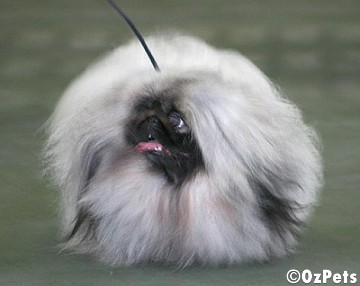 Appearance
Appearance
The Pekingese breed is over 2000 years old and has hardly changed in all that time. One exception is that modern breeders and dog-show judges seem to prefer the long-haired type over the more-traditional spaniel-type coat.
All breed standards allow all sorts of color combinations. The most common is gold; this is the color of the majority of Pekingese exhibited. Although the breed once came in a variety of colours, the majority of Pekingese are gold, red or sable. Light gold, cream, black, white, sables, black and tan and occasionally 'blue' or slate grey have appeared in the breed. The latter often has poor pigment and light eyes. Albino Pekingese (white with pink eyes) should be bred cautiously due to health problems that have been associated with albinism.
The Chinese bred them to be companions to the Emperor of China and his ladies and eunuchs. They have short legs that are bowed. It is said that this was done to discourage wandering. However, they can and will keep up with the big dogs when allowed. The bowed legs makes their walk, run, or trot quite striking. The juvenile appearance of the Pekingese has been attributed to the artificial, perhaps inadvertent, paedomorphosis of an "ancestral" form of the dog through breeding.
Pekes weigh from 7 to 14 pounds (3-6 kg) and stand about 6-9 inches (15-23 cm) at the withers.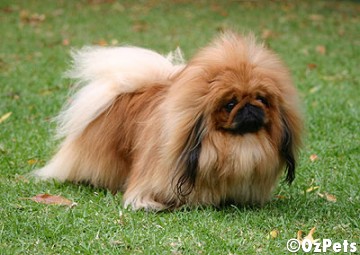 Temperament
Temperament
These dogs can be stubborn and jealous. Do not expect this dog to come when it is called. Pekes are sometimes aggressive, especially to other dogs. It may take a long time for Pekes to get used to any other dogs except puppies, mates, and siblings. However, Pekes can be properly socialized with dogs and other types of pets and can become fast friends. It is easy to believe that Pekes know that they are royalty and expect you to know it too. The Pekingese personality has been compared to a cat, although this isn't quite right. Where a cat can be trained, a Pekingese needs to be convinced that the training is beneficial to him as well as to you. But, if they love you they will do anything for you, even fight to the death to protect you.
The Pekingese is generally a one-person dog. Many breeders will not place the breed in households with young or boisterous children as the Breed simply does not enjoy being mauled or expected to tear around in a manner that would be more befitting an agile Poodle or other small breeds.
The Pekingese is a large dog in a small body. It expects to be respected and will not tolerate being treated otherwise.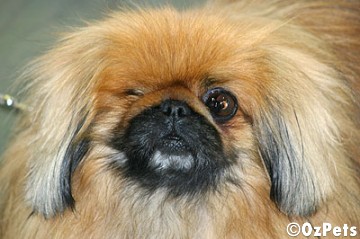 Health
Health
The leading cause of death for Pekes, as for many other Toy breeds, is congestive heart failure. When diagnosed early and successfully treated with medication, a Peke with this problem can expect to live many years. A heart murmur is a potential sign of a problem, and must be evaluated by a veterinary cardiologist. Very often, the problem does not surface until the dog is 6 or more years old, so it is very difficult to screen the problem in a pup. Pekes' other main problems are eye issues and breathing problems, resulting from its tiny skull and flattened face, and skin allergies (and hotspots). An especially common problem is eye ulcers, which may develop spontaneously. Pekes should never be kept outside as their flattened faces and noses can develop breathing problems, which makes it difficult for them to regulate their body temperature in overly hot or cold weather. Their long backs, relative to their legs, make them vulnerable to back injuries. Care should be taken, when picking them up, to give Pekes adequate back support: one hand under the chest, the other under the abdomen. Short legs give some Pekes difficulty with stairs; older dogs may not be able to go up or down stairs alone.
Care
Keeping the Peke coat healthy and presentable requires brushing once a day. If you do this, they will need to see a groomer only once every 3 months. If a Peke becomes dirty, it is important to take it to a groomer as soon as possible, as it is difficult to remove dirt from its coat once it has dried, but this can be avoided if by brushing regularly, especially the belly, and between the front and hind legs. One important thing for new owners to remember is that dogs intended as a house pet may be kept in a puppy cut which is much more low maintenance than a show cut. It is also important to remove dirt from the eye pores daily, and from the creases on the face to prevent sores (hotspots).